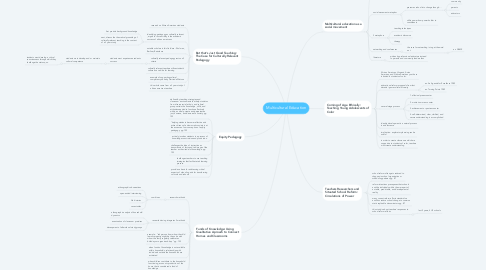
1. But that's Just Good Teaching: The Case for Culturally Relevant Pedagogy
1.1. research on African American students
1.2. identifying pedagogy as culturally relevant , argue for its centrality in the academic success of african americans
1.2.1. first provide background knowledge
1.2.2. next, discuss the theoretical grounding of culturally relevant teaching in the context of a 3 year study
1.3. notable scholars in this field are : Shulman, Berliner, Bartoleme
1.4. culturally relevant pedagogy rests on 3 criteria
1.4.1. students must experience academic success
1.4.1.1. students must develop and or maintain cultural competence
1.4.1.1.1. students must develop a critical consciousness through which they challenge the status quo
1.5. culturally relevant teachers utilize student's culture as a vehicle for learning
1.6. example of supporting cultural competency done by Gertrude Wintson
1.7. this article came from a 3 year study of african american teachers
2. Equity Pedagogy
2.1. defined by teaching strategies and classroom environments that help studetns from diverse racial, ethnic, and cultural groups attain the knowledge , skills, and attitudes needed to function effectively within, and help create and perpetuate a just, humane, and democratic society. pg. 152
2.2. "helping students become reflective adn active citizens of a democratic society is at the essence of our conception of equity pedagogy. pg. 152
2.3. actively involves students in a process of knowledge construction and production.
2.4. challenges the idea of instruction as transmissoin of facts and teh image of the teacher as the citadel of knowledge. pg. 153
2.5. challenges teachers to use teaching strategies that facilitate teh learning process.
2.6. provides a basis for addressing critical aspects of schooling adn for transforming curricula and schools .
3. Funds of Knowledge: Using Qualitative Aproach to Connect Homes and Classrooms
3.1. research methods
3.1.1. combines
3.1.1.1. ethnographic observations
3.1.1.2. open-ended interviewing
3.1.1.3. life histories
3.1.1.4. case studies
3.2. research desing integrates 3 methods
3.2.1. ethnographic analysis of household dynamics
3.2.2. examinaiton of classroom practices
3.2.3. deveopment of afterschool study groups
3.3. example : "teh person from whom the chld learns carpentry might be the uncle with whom the famly regularly celebrates brithdays or organizes bbqs " pg. 133
3.4. when funds of knowledge is not available within households, relationships with individuals outside the households are activiated
3.5. when children contribute to the household functioning, economic production of the home that is considered a fund of knowledge
3.6. subject of the study: Mexican American in Tuscon, AZ
4. Multicultural education as a social movement
4.1. outgrowth of civil rights movement
4.1.1. 1960s and 1970s, multicultural educaiton not noticed by educational establishment
4.2. social movement metaphor
4.2.1. pressures school into change though....
4.2.1.1. community
4.2.1.2. parents
4.2.1.3. educators
4.2.2. shifts power from power holder to constituents
4.3. 3 metaphors
4.3.1. teaching techniques
4.3.2. academic discourse
4.3.3. therapy
4.4. networking and conferences
4.4.1. the case for networking is to get the word out
4.4.1.1. ex. NAME
4.5. literature
4.5.1. written by professional educators instead fo parents and community leaders thus
5. Coming of Age Ethically: Teaching Young Adolescents of Color
5.1. African American, Hispanic, Asian American, and Native American youth are included in students of color.
5.2. educational reform proposals from last decade ignore cultural diversity
5.2.1. ex. An Agenda for Excellence 1985
5.2.2. ex. Turning Points 1989
5.3. several stage process
5.3.1. 1. affusion/ preencounter
5.3.2. 2. moritorium or encounter
5.3.3. 3. achievement or post-encounter
5.3.4. 4. self-determined, clear, clarified, and secure understanding is accomplished
5.4. identity development is a natural process in adolescence
5.5. implication: exploratory learning can be useful
5.6. in order to create classrooms which are supportive to students of color, teachers must create understanding
6. Teachers Researchers and Situated School Reform: Circulations of Power
6.1. school reform often gets reduced to chagnes in school organization or scheduling patterns pg. 87
6.2. reform intentions presaposes that schools and the individuals within them are part of a stable, predictable, and developmental reality
6.3. many current reform efforts standardize and thus reduce school change to common static replicable denominators pg. 87
6.4. this study is about teachers' responses to school reform efforts
6.4.1. last 5 years, 4 US schools

